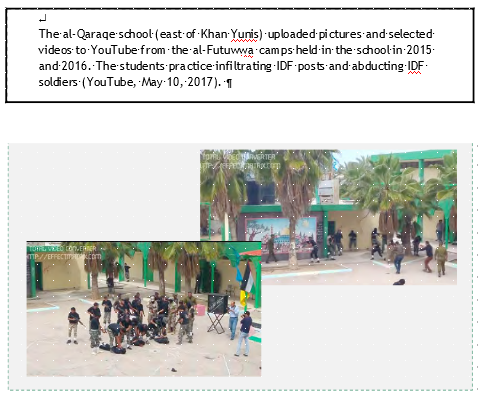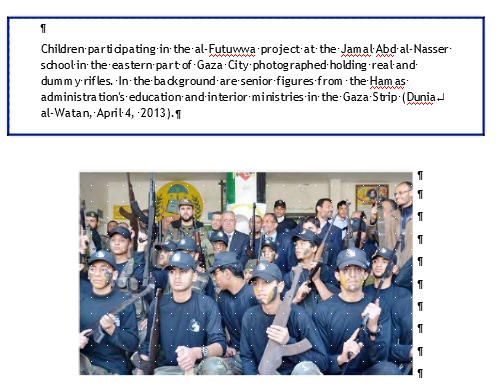
Page
Buttons

‘Together’
to
Peace and Prosperity
for Palestinians and Jews
|
|
|
|
|
|
|
|
|
|
|
|
|
|
|
Payments to Jailed Palestinians and ‘Martyrs’ by the Palestinian AuthorityP |
|
|
|
|
|
|
|
|

Buttons Bar for more information
|
PART 1 T O P I C |
|
|
|
|
|
|
|
|
|
|
|
|
|
|
|
|
|
|
JewishWikipedia.info
|
Has Given |
Amending the |
THE
INCREDIBLE
STORY OF THE JEWISH PEOPLE
Editor’s Note: These functions are split. Education an Healthcare by UNRWA for Palestinian Refugees and by the State for registered citizens.
Israel is usually called in where local facilities cannot meet requirements.
__________________________________________________________
EDUCATION
UNRWA
SPENDS MORE THAN HALF OF ITS BUDGET ON EDUCATION.
World Education Blog
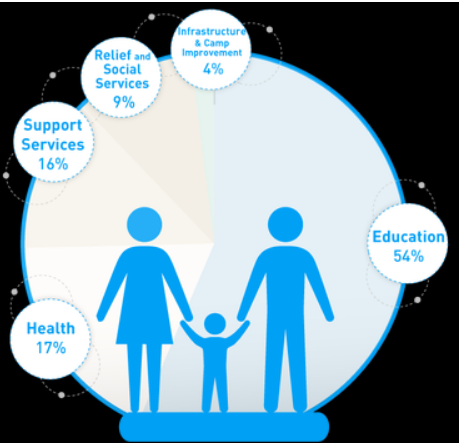 As its website tells us, and as we heard from its director of education on this blog site last year, with the help of these funds, the UNRWA/UNESCO education programme operates in no fewer than 677 elementary and preparatory schools, providing free basic education for around half a million Palestinian refugee children (54%) .
As its website tells us, and as we heard from its director of education on this blog site last year, with the help of these funds, the UNRWA/UNESCO education programme operates in no fewer than 677 elementary and preparatory schools, providing free basic education for around half a million Palestinian refugee children (54%) .
Quite apart from just giving these children seats in classrooms, we showed that most children in UNRWA schools perform as well as, or better than, those in host country schools in Jordan, Gaza and the West Bank.
NRWA also provides TVET training for 7,000 Palestinian refugees in all fields and for 2,100 students in two educational science faculties and teacher training institutes (one in the West Bank and one in Jordan). UNRWA students’ literacy and levels of educational attainment are among the highest in the Middle East.
(Information is from the UNRWA Annual Report, 2017)
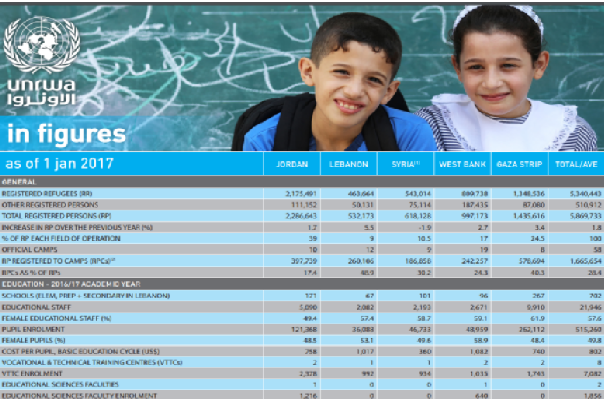
In Gaza, 252 UNRWA schools serve over 240,400 students. These children grow up in bleak conditions, frequently surrounded by poverty and violence. School provides them with one place where they are able to learn the skills for a better future.
Years of underfunding have left the education system in Gaza overstretched, with 94 per cent of schools operating on a double-shift basis, hosting one 'school' of students in the morning and a different group in the afternoon. As a result, children’s education is severely truncated. In 2006 examinations, nearly 80 per cent of students failed mathematics, and more than 40 per cent failed Arabic.
In the West Bank, UNRWA provides only preparatory education; secondary students matriculate into national schools. Nonetheless, we operate 97 educational facilities in the field, which reach over 50,000 students. The Agency also operates two vocational training centres, where over 1,000 students are trained in skilled trades and manufacturing.
he 2011/12 academic year saw a significant decrease in violence in and around UNRWA school premises. This was matched by an increase in achievement, with UNRWA West Bank schools outperforming Palestinian Authority (PA) schools in nationally and internationally administered scholastic achievement tests.
ung Palestine refugees, many of them students, have been especially vulnerable to the effects of the conflict in Syria. Because the majority of UNRWA schools are located within the Palestine refugee camps themselves – in areas that have suffered serious violence – one of the most pernicious of these effects has been a disruption in their education.
Before the outbreak of the conflict, all of the 118 UNRWA schools in Syria were running on double shifts to provide around 67,300 students with primary and secondary education, following the Syrian curriculum. Violence, damage, closures and other factors, however, have left only 42 of those 118 schools operational as of March 2014. Some of these schools are now operating three shifts. We are also educating some of our students at 43 government schools, which the Ministry of Education has agreed to let UNRWA use in the afternoons.
Lebanon is the only field where we offer secondary education. In total, we serve 38,173 students at 68 schools throughout the country. UNRWA also operates one vocational training centres, which reach 1,143 students.
In Jordan, UNRWA provides basic education to over 118,500 students at 174 UNRWA schools. tudents in the fourth, eighth and tenth grades take national quality-control tests in the core subjects – Arabic, English, science and maths – and consistently achieve better results than students from private or government schools.
We are also excited to be able to provide university education in teaching, Arabic and English to about 1,200 students through the Faculty of Educational Sciences and Arts. We plan to add a fourth specialty, geography, in the 2013/14 academic year.
UK HAS GIVEN $427 MILLION N AID TO UNRWA IN PAST FIVE YEARS
COUNT THE MARTYRS:
UK TO REVIEW FUNDS FOR PALESTINIAN SCHOOLS
WHOSE BOOKS INCITE
LONDON SAYS IT’LL LOOK AT TENS OF MILLIONS GIVEN TO
UN REFUGEE AGENCY; ONE PHYSICS BOOK DISCUSSES USE OF SLINGSHOTS AGAINST IDF SOLDIERS, OTHERS PRAISE TERRORISTS
Times of Israel, TOI Staff. 22 February 2020
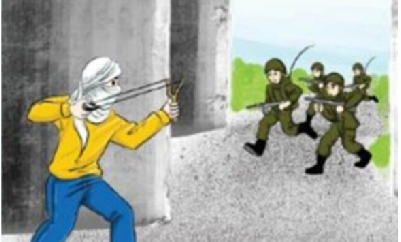 An image said to be from a Palestinian school textbook covering physics which shows a Palestinian boy shooting a slingshot at Israeli soldiers. The caption, according to the Daily Mail, reads: 'What is the relationship between the elongation of the slingshot's rubber and the tensile strength affecting it? What are the forces that influence the stone after its release from the slingshot?' (Courtesy IMPACT-se)
An image said to be from a Palestinian school textbook covering physics which shows a Palestinian boy shooting a slingshot at Israeli soldiers. The caption, according to the Daily Mail, reads: 'What is the relationship between the elongation of the slingshot's rubber and the tensile strength affecting it? What are the forces that influence the stone after its release from the slingshot?' (Courtesy IMPACT-se)
British officials have pledged to urgently review the tens of millions of dollars in aid the UK provides to the UN agency for Palestinian refugees, after an investigative report found that a majority of the funds have been going to schools in the West Bank and Gaza Strip which use textbooks that incite violence against Israelis.
According to a Friday report in the UK-based Daily Mail, the Department for International Development and its secretary, Anne-Marie Trevelyan, vowed to raise the issue with the Palestinian Authority, adding that London was working to carry out an independent review of the Palestinian textbooks.
The UK Government has a zero tolerance approach toward incitement to violence,” a spokesman for the department told the Daily Mail.
The Daily Mail report included several examples of alleged incitement uncovered in textbooks used at schools funded by the UN Relief and Works Agency for Palestine Refugees (UNRWA). In one math textbook for nine-year-olds, students are asked to add up the number of martyrs from Palestinian uprisings, accompanied with images of their funerals. In another, 11-year-olds are taught Newton’s Second Law of Physics with a depiction of a boy pointing a slingshot at Israeli soldiers.
her photos showed Palestinians using slingshots against Israeli forces and quizzed students on their potential use and effectiveness, as well as precautions to employ while using them.
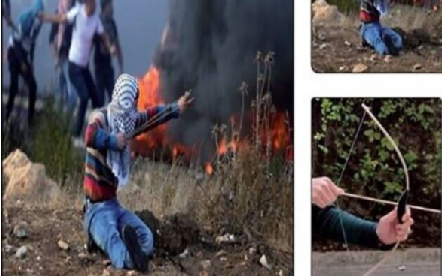 An image said to be from a Palestinian school textbook shows Palestinians using various weapons against Israeli soldiers. The caption, according to the Daily Mail, reads: ‘During the Palestinian Stone Uprising of 1987, the youth of Palestine used a slingshot or the ‘shu’ba’ to confront the bullets of the Occupation army soldiers who were breaking into Palestinian towns. The Palestinians had no other means of defending themselves. Answer the questions: 1. Have you seen a slingshot in your environment? What are its uses? 2. What is its usefulness for shooting stones? How does it work? 3. Examine the forms of energy transformations of the stone, from the moment it is set in the slingshot position until its launch toward the target. 4. Formerly, bows and arrows were used as a means of self-defense. Explain the principle of how it [the bow] works in launching an arrow toward the goal and compare it with the principle of how slingshots worked in the Palestinian stone uprising. 5. What safety precautions should be taken into account when using the slingshot?’ (Courtesy IMPACT-se)
An image said to be from a Palestinian school textbook shows Palestinians using various weapons against Israeli soldiers. The caption, according to the Daily Mail, reads: ‘During the Palestinian Stone Uprising of 1987, the youth of Palestine used a slingshot or the ‘shu’ba’ to confront the bullets of the Occupation army soldiers who were breaking into Palestinian towns. The Palestinians had no other means of defending themselves. Answer the questions: 1. Have you seen a slingshot in your environment? What are its uses? 2. What is its usefulness for shooting stones? How does it work? 3. Examine the forms of energy transformations of the stone, from the moment it is set in the slingshot position until its launch toward the target. 4. Formerly, bows and arrows were used as a means of self-defense. Explain the principle of how it [the bow] works in launching an arrow toward the goal and compare it with the principle of how slingshots worked in the Palestinian stone uprising. 5. What safety precautions should be taken into account when using the slingshot?’ (Courtesy IMPACT-se)
Textbooks were found to praise Palestinian “martyrs,” including Dalal al-Mughrabi, who led the 1978 Coastal Road Massacre during which Palestinian terrorists hijacked a bus and murdered 38 Israelis.
The materials revealed by the Daily Mail and their translations were provided to the paper by the Institute for Monitoring Peace and Cultural Tolerance in School Education (IMPACT-se).
he UK has given some $427 million in aid to UNRWA over the past five years with another $84 million pledged for the coming year. Roughly 62 percent of that funding goes to schools in the Palestinian territories, which could be using such textbooks.
Responding to the Daily Mail report, UNRWA said in a statement that it “cannot alter host government curriculum as this is a matter of national sovereignty, but it does have robust systems in place to ensure education delivered in its schools reflects UN values.”
ge said to be from a Palestinian school textbook praises Palestinian terrorist Dalal al-Mughrabi, who took part in the 1978 massacre of 38 Israelis (Courtesy IMPACT-se)
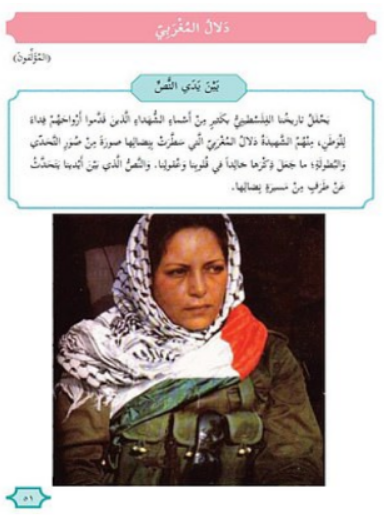 Last May, the European Union announced that it would conduct an examination of new Palestinian school textbooks following a study that found them to be more radical than in the past and containing incitement and rejection of peace with Israel.
Last May, the European Union announced that it would conduct an examination of new Palestinian school textbooks following a study that found them to be more radical than in the past and containing incitement and rejection of peace with Israel.
The development came after the European Parliament in April 2018 passed legislation geared to prevent hateful content in Palestinian textbooks. In October of that year the parliament’s budgetary committee recommended freezing more than $17 million in aid to the Palestinian Authority over incitement against Israel in its textbooks.
The EU hands the PA 360 million euros ($404 million) per year, with most earmarked for its education ministry. In addition, the European body donates $178 million to UNRWA, much of which goes to its schools that teach the PA curriculum.
AMENDING THE SCHOOL CURRICULUM
Hamas and the Palestinian Authority's ministry of education undermine UNRWA's intention to slightly moderate the curriculum used in its schools. The dispute between them raised the problem of Palestinian textbooks, which are infused with hostility towards Israel
It was decided not to change the PA curriculum
also taught in UNRWA schools in the Gaza Strip
The Meir Amit Intelligence and Terrorism Information Center
May 16, 2017.
OVERVIEW
1. In recent months there has been a dispute between Hamas and UNRWA over the agency's intention to make changes in the curriculum used in UNRWA elementary schools in the Gaza Strip. Hamas claims the changes UNRWA intends to introduce are intended to harm the "national identity" of young Palestinians and serve Israel. In an effort to prevent changes from being introduced Hamas announced its strenuous objection and initiated "popular" demonstrations in the refugee camps in the Gaza Strip1 In addition, Sabri Sidam, Palestinian Authority (PA) Minister of Education and Higher Education, also expressed his opposition to changes in the curriculum, and announced the suspension of the ministry's ties with UNRWA.
1 See the April 2, 2017 bulletin, "Hamas Strongly Attacks UNRWA for Its Intention to Introduce Changes in the Curriculum of Its Elementary Schools."
2. Apparently UNRWA did in fact consider making slight modifications to problematic issues in the Palestinian textbooks by adding "enrichment material" (UNRWA does not have the authority to unilaterally change the PA's textbooks). However, after the strenuous opposition voided by both Hamas and the PA's ministry of education, UNRWA Commissioner General Pierre Krähenbühl, met with Rami Hamdallah, prime minister of the Palestinian national consensus government, and Sabri Sidam, the Palestinian minister of education. After the meeting Hamdallah announced that there would be "no change in the curriculum in UNRWA's schools" and that "any change will be carried out only after full consultation with the ministry of education."
3. Studies, both recent [see below] and past, indicate that the PA's textbooks teach the younger Palestinian generation the ideology of struggle against Israel, fundamental hostility towards Israel, refusal to accept Israel's existence, a disregard for the strong ties of the Jewish people to the Land of Israel and adherence to the so-called "right of return" of the Palestinian refugees. The ideology of struggle and hatred towards Israel is manifested, among other ways, in the PA's textbooks. That blatantly contradicts the claim made by Mahmoud Abbas at the press conference he held with Donald Trump at the White House. Mahmoud Abbas said, "we educate our children, our descendants and our sons on a culture of peace. We are working to have them live in security, freedom and peace like the other children in the world, among them, children in Israel" (Wafa, May 3, 2017).
4. In ITIC assessment, UNRWA finds itself is in a quandary when it comes to the sensitive issue of textbooks, as well as other unsettled issues with Hamas (for example the double identities of Hamas activists who are employed by UNRWA). On the one hand, UNRWA is under pressure from Hamas and the local population controlled by Hamas (and in this case, joined by the PA). On the other, UNRWA's budget is being threatened with cuts by the donor countries (especially the United States), which exert pressure on the agency and demand it make changes in the way it is run. Apparently, in the meantime the pressure on the ground has more influence on the agency.
2 Pierre Krähenbühl was born in Geneva, Switzerland. He holds a B.A. in Political Science and International Relations from the University of Geneva and an M. A. from the Graduate Institute of International and Development Studies. He has been UNRWA's Commissioner General since March 2014, appointed by then Secretary General Ban Ki-moon. He serves at the level of Under Secretary General.
THE SEQUENCE OF EVENTS
5. On March 16, 2017, Hamas' organ al-Risalah published an article by Wassam Afifa, which gave examples of changes in the curriculum which Hamas claimed UNRWA was planning to make:
a. Removal of maps of Palestine from textbooks and no mention of Jerusalem as the capital of Palestine.
b. No mention of cities in Israel which were "occupied" by Israel in 1948: "...In describing the weather and climate in a city like Tiberias, Tiberias was replaced by Gaza, and Safed was replaced by Nablus. Thus we are prevented from even mentioning our cities occupied [by Israel] since 1948. [That is] an outrageous blow to our [Palestinian] principles" [Note: Hamas regards Tiberias and Safed as "occupied Palestinian cities" and for Hamas, Israel has no right to exist].
c. Coeducational education: showing boys and girls together dancing the debka [a Middle Eastern folk dance] in lessons about Palestinian traditions.
d. No use of the word "Palestine" as a didactic measure to teach the letter "t." To teach the letter in the first grade, the word yaqtin (pumpkin) is used instead of "Palestine" (leading Wassam Afifa to write, "UNRWA turns Palestine into a pumpkin").
e. No glorification of Palestinian prisoners: a play about Palestinian villages welcoming released prisoners was replaced with "a fairy tale about people welcoming a prince."
f. Improving the image of Israel: UNRWA removed the topic of "rebuilding a home which the occupation [i.e., Israel] destroyed in the West Bank and Jerusalem."
6. Hamas was joined in its strenuous opposition to curriculum changes by Sabri Sidam, minister of education and higher education in the Palestinian national consensus government in Ramallah. He told the media that his ministry would not permit UNRWA to change the curriculum (al-Araby al-Jadeed, March 29; i24news.tv, March 25, 2017). To increase the pressure on UNRWA, the Palestinian ministry of education in Ramallah decided, on April 13, 2017, to suspend its relations with UNRWA.
7. Sabri Sidam, Palestinian minister of education, told Palestinian TV that until UNRWA changed its mind, relations with the agency would not be renewed. He called for a "peaceful intifada" against UNRWA and appealed to the Palestinian UNRWA staff and the "popular committees" in the refugee camps to rise up against UNRWA's intention "in cultural ways" and to quietly protest UNRWA's intention to change the curriculum (in a video uploaded to YouTube on April 13, 2017, by a Palestinian named Fathi Abu Sa'ada from Khan Yunis. It included a segment from an interview given by Sabri Sidam, Palestinian minister of education, to Palestinian TV. The subject of the interview was the suspension of relations with UNRWA).
UNRWA ANNOUNCES IT WILL NOT CHANGE ITS CURRICULUM
8. Apparently the combination of pressure from both Hamas and the Palestinian ministry of education bore fruit and led UNRWA not to carry out its intentions. On April 17, 2017, Rami Hamdallah met in his office in Ramallah with Pierre Krähenbühl, Commissioner General of UNRWA. According to an announcement later released by UNRWA, they discussed the various issues related to the Palestinian refugees, among them the issue of the curriculum taught in UNRWA schools. According to Krähenbühl, "The discussion with the Prime Minister was very important, reflecting the solid and constructive partnership between the Palestinian government and UNRWA" (UNRWA website, April 17, 2017).
9. Krähenbühl told that, in conformity with its practice since the 1950s, based on an agreement with UNESCO, UNRWA taught host-country curricula in its schools. That included the Palestinia Authority's curriculum and he said UNRWA has no intention of changing the practice. He told the Prime Minister that it had "long been UNRWA's practice to review newly issued textbooks and to produce enriching teaching material." That was done, he said, through dialogue with the Palestinian Authority, in particular the ministry of education and higher education, and in full recognition of the right of Palestinian students to learn about their identity, history and culture. 3
10. As opposed to the convoluted announcement from UNRWA, the Palestinian announcement about the meeting was shorter and far clearer: Rami Hamdallah the prime minister of the Palestinian national consensus government, reported on his Facebook page that at the meeting it had been decided that "no change will be made in the curriculum taught in UNRWA schools" and that "any change will be made in full consultation with the ministry of education [of the Palestinian national consensus government]."
3 https://www.unrwa.org/newsroom/press-releases/commissioner-general-unrwa-meets-palestinian-primeminister-ramallah

Facebook page of Palestinian prime minister Rami Hamdallah: at the meeting with Pierre
Krähenbühl, the decision was made not to change the curriculum taught in UNRWA schools (Facebook page of Rami Hamdallah, April 17, 2017)
11. The day after the meeting, April 18, 2017, Sabri Sidam, the Palestinian minister of education, met in his office in Ramallah with Pierre Krähenbühl. The results of the meeting were posted to the Palestinian ministry of education's Facebook page:
A. "The UNRWA Commissioner General noted the agency's ful commitment to the Palestinian curriculums. He said no change would be made that would harm the curriculums" (Facebook page of the Palestinian ministry education, April 18, 2017).
B. "Pierre Krähenbühl explained that the agency [UNRWA] considered itself a primary partner of the [Palestinian] ministry of education, especially in the field of education. He said it was the right of Palestinian children to receive a high-quality education and preserve the fundamentals of their identity and culture. He praised the active cooperation between UNRWA and the ministry [of education], which is manifested by the intensive efforts invested for Palestinian students, and said
that all enrichment of material in Palestinian textbooks would be coordinated between the [Palestinian] ministry [of education] and the agency" (Facebook page of the Palestinian ministry education, April 18, 2017).
THE PROBLEMATIC NATURE OF PALESTINIAN TEXTBOOKS
12. The affair of amending the Palestinian textbooks is not, in ITIC assessment, a unique event in the relations between UNRWA and Hamas and the PA. Rather,it reflects a problem deeply rooted in principle. UNRWA, which runs (and funds) its education system in Palestinian refugee camps, is forced to use textbooks issued by the Palestinian ministry of education which inculcate the ideology of struggle against Israel, hatred and hostility towards it. Absent are universal values and peace. UNRWA's attempts to make even minor adjustments, especially in view of the pressures exerted by donor countries, again failed.
13. Reports issued over the past ten years have repeatedly indicated that hostility toward Israel is ingrained in the Palestinian curriculum. The most recent report was issued by IMPACT-se (Institute for Monitoring Peace and Cultural Tolerance in School Education) of the Hebrew University in Jerusalem, which dealt with astudy of textbooks and curriculums to promote peace and tolerance through education. The study was carried out by Dr. Eldad J. Pardo from the Hebrew University and entitled "Palestinian Elementary School Curriculum 2016-17: Radicalization and Revival of the PLO Program" (April 2017).
14. The executive summary of the report begins, "The new Palestinian curriculum, which includes new textbooks for grades 1-4, is significantly more radical than previous curricula. To an even greater extent than the 2014-2015 textbooks, the curriculum teaches students to be martyrs, demonizes and denies the existence of Israel and focuses on a "return" to an exclusively Palestinian homeland." It continues, "Within the higher-grade textbooks, there remain an absolute lack of empathy for the "Other," nor any comprehension or explanation of the root causes of the conflict between Palestinians and Israelis. Thus the hatred of Israel persists" (ITIC emphasis throughout).
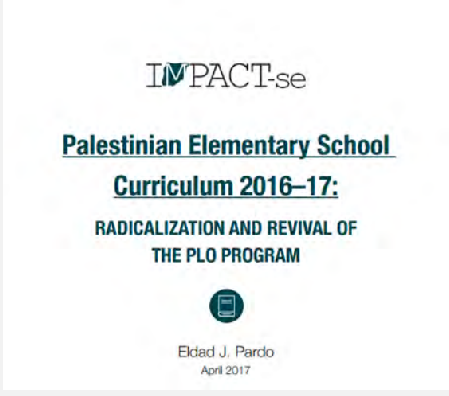
The front page of the study carried out by Dr. Eldad Pardo for IMPACT-se of the Hebrew University in Jerusalem.
15. The findings of the study were consistent with those of two other studies done on Palestinian textbooks. One was published by a German research institute in 2016 and the other by the Intelligence and Terrorism Information Center in 2006.4 The similarity of all the findings demonstrates the consistent, systematic education provided for the younger Palestinian generation which inculcates the children with hostility towards Israel, even if the textbooks are occasionally replaced. The findings of the studies contradict the remark made by Mahmoud Abbas at a press conference held with Donald Trump at the White House, where he claimed, "we educate our children, our descendants and our sons on a culture of peace. We areworking to have them live in security, freedom and peace like the other children in the world, among them, children in Israel" (Wafa, May 3, 2017).
4 The study was carried out by the German institute "Mideast Freedom Forum Berlin" (MFFB), which, according to its website, has, "Over the past years...worked to combat anti-Semitism, hostility towards Israel, Islamism and right-wing extremism." On March 12, 2016, it published a report called "Educating the Next Generation. Changing Palestinian Textbooks as a Precondition for Mutual Understanding." Its main findings appear under the title "An Analysis of the Representation of Israel and Jews in Palestinian Textbooks." For a discussion of the report see the April 20, 2016 bulletin "About the Report of the Mideast Freedom Forum Study of Palestinian Authority Textbooks by Brigadier General (Ret.) Amos Gilboa."
Another study published on March 7, 2006 was written by Ms. Noa Meridor, "An examination of Palestinian fifth and tenth-grade textbooks for the 2004-2005 school year shows a continuing denial of the State of Israel’s right to exist and a continuing cultivation of the values of armed struggle against Israel. The books contain incitement against the State of Israel and the Zionist movement, one of them
even employing anti-Semitism."
16. The educational policies which foster hostility towards Israel, and are reflected in the Palestinian textbooks, are manifested more strongly in the Gaza Strip. In Gazan schools the policies are accompanied by informal education led by principals and teachers who are affiliated with Hamas. They inculcate the schoolchildren with Hamas' radical Islamist ideology, not necessarily based on textbooks. Schools not run by UNRWA allow semi-military training to be held on their premises (the al-Futuwwa, "youth, heroism," program), to prepare the younger generation to join the ranks of Hamas in the future.
RITAIN GIVES £20M TO PALESTINIAN SCHOOLS
TEACHING JIHAD, MARTYRDOM
Minister says UK is paying wages of 33,000 teachers who teach curriculum that includes
the physics of using slingshots to attack IDF soldiers
and the glory of dying for Palestine
Times of Israel, Stuart Winer and TOI Staff, 2 April 2018
The British government last year gave £20 million to Palestinian schools teaching a curriculum that a watchdog group says embraces jihad, omits references to peace agreements with Israel, and encourages martyrdom, the Sunday Times reported.
A review by the Institute for Monitoring Peace and Cultural Tolerance in School Education (IMPACT-se) found that study material from the Palestinian Authority textbooks “exerts pressure over young Palestinians to acts of violence.”
Among the ideas taught to pupils are the physics behind slingshots used to hurl rocks at Israel soldiers, the glorification of martyrs, and images that infuse ideas of war.
“The curriculum exerts pressure over young Palestinians to acts of violence in a more extensive and sophisticated manner,” IMPACT-se wrote. “The discourse is couched in terms of nationalist and religious martyrdom, across science, literature, history and religious education textbooks.”
“With a comprehensive and oft-stated justification for defensive (obligatory) jihad, the curriculum’s focus appears to have expanded from demonization of Israel to providing a rationale for war,” it continued.
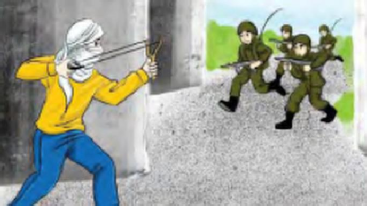 In answers given to the UK parliament, Minister of State for International Development Alistair Burt revealed that UK taxpayers’ money is funding the wages of 33,000 teachers who use the new curriculum, the Times said.
In answers given to the UK parliament, Minister of State for International Development Alistair Burt revealed that UK taxpayers’ money is funding the wages of 33,000 teachers who use the new curriculum, the Times said.
Speaking last week, Burt said that “all of their [the PA’s] schools in the West Bank are using the revised 2017 PA curriculum. UK-funded public servants and teachers . . . are therefore involved..”
Member of parliament Joan Ryan, chairwoman of Labour Friends of Israel, denounced the funding of schools that use the curriculum.
“It is absolutely appalling that UK taxpayers’ money is helping to support the teaching of a curriculum which incites violence and terrorism and spreads anti-Semitism,” she said. “The government must immediately suspend all aid to the Palestinian Authority until it commits to wholesale and urgent revisions of the curriculum.”
The Department for International Development responded to the Times in a statement saying “Our support is helping around 25,000 young Palestinians go to school each year. The UK government strongly condemns all forms of violence and incitement to violence.”
In August the Palestinian Authority introduced a new school curriculum for grades 5-11. In a review published in October, IMPACT-se found that “radicalization is pervasive across this new curriculum, to a greater extent than before.”
Sacrifice of life is also encouraged for girls in the context of equal rights and heroes are those who “sacrificed their souls.”
“They [hereos] taught people that drinking the cup of bitterness with glory is much sweeter than a pleasant long life accompanied by humiliation,” reads one 5th grade Arabic-language textbook according to an English translation in the IMPACT-se report.
“Giving one’s life [fida’], sacrifice, fight, jihad and struggle are the most important meanings of life,” another text urges.
A science text book ties physics principles to attacking Israeli soldiers with slingshots.
“During the first Palestinian uprising, Palestinian youths used slingshots to confront the soldiers of the Zionist Occupation and defend themselves from their treacherous bullets,” the text reads. “What is the relationship between the elongation of the slingshot’s rubber and the tensile strength affecting it?”
Social studies books include images of children sitting in school rooms with some desks empty except for a sign reading “martyr.”
“Israel, regardless of boundaries, is depicted as an affront to Arab nationalism, part of a series of divisions imposed on the Arab Homeland by colonial powers,”IMPACT-se noted. “In many cases the curriculum does not use the name ‘Israel’ or ‘Israelis.’ Instead, it uses the ‘Occupation,’ ‘Zionist Occupation,’ ‘Zionists’ or metaphors like invaders and oppressors.”
References to the two-state solution for peace are not included in text books, as are any United Nations calls for an end to the violence, found the report by the Jerusalem-based group.
A Grade 11 history text book on the Oslo Accords that lead to the creation of the the Palestinian Authority has “no reference to peace, exchange of letters of recognition, transfer of territories from Israel to the PLO or the Nobel Peace Prize,” IMPACT-se said.
The Israeli government has long argued that incitement in Palestinian textbooks is a main contributor to hatred and terrorism against Israelis. Palestinian officials counter that draconian Israeli measures and decades of occupation, not incitement, instill hatred and inspire terrorism.
The issue has taken on increasing significance of late, as members of Congress have threatened to decrease US aid to Palestinians if incitement is not curbed.
Agencies contributed to this report.
_____________________________________________________
HEALTHCARE
UNRWA
REPORT 2017 (CLICK ON THIS LINK FOR MORE DETAIL)
UNRWA’s primary mission is to assist Palestine refugees in Jordan, Lebanon, Syria, West Bank and the Gaza Strip to achieve their full potential in human development, pending a just solution to their plight. UNRWA’s services encompass education, health care, relief and social services, camp infrastructure and improvement, microfinance and emergency assistance. UNRWA is funded almost entirely by voluntary contributions. UNRWA has its Headquarters (HQ) in Amman, Jordan, and the Gaza Strip, which coordinate the activities of the the five Field Offices (FOs).
UNRWA’s health system has three tiers:
- Headquarters: handles policy and strategy development.
- 5 Field Departments of Health: concerned with operational management.
- 143 Health Centres: provide health services to Palestine refugees
The Department of Health employs over 3,320 staff throughout the three tiers, including around 475 doctors. About 3.6 million Palestine refugees; the served population or beneficiaries, out of the some 6.0 million registered, eligible UNRWA health services free of charge. UNRWA does not operate its own hospitals (except for one Qalqilia Hospital, in the West Bank), but instead operates a reimbursement scheme for its beneficiaries.
ACCESS TO HEALTHCARE FOR CHILDREN IN PALESTINE
Tony Waterston (Institute of Health and Society, Newcastle upon Tyne, UK), Dina Nasser (Juzoor for Health and Social Development,
Ramallah, Palestine),
BMJ Journals November 25, 2017 to read article click link
ABSTRACT
Currently, 5 million Palestinian refugees live in Palestine, Jordan, Syria and Lebanon and around 40% of these are children. Mortality rates for Palestinian children are comparable to neighbouring Arab countries but the speed of reduction has faltered in recent years. Morbidity is greatly affected by the occupation which has increased violence towards children, mental health problems and poor nutrition, particularly in Gaza which is experiencing a health crisis. Access to healthcare for children in Palestine is constrained as a result of the requirement for visas to travel into Jerusalem where specialist hospitals are sited, by difficulties with ambulance transfers, by shortages of equipment in hospitals and by lack of trained staff. Palestinian health workers are developing new initiatives in healthcare and show a high level of resilience, despite the very considerable stress affecting most citizens.
WITH HEALTHCARE FALTERING IN GAZA,
CARE IN ISRAEL IS SOUGHT AFTER
World News GAZA (Reuters) Nidal al-Mughrabi, APRIL 6, 2017
For many patients suffering from life-threatening diseases in the Gaza Strip, treatment in neighboring Israel or the occupied West Bank is a much sought-after option.
But Israel tightly restricts Palestinian passage from the Gaza Strip, one of its bitterest enemies. Although it exempts from the ban Gazans seeking “life-saving or life-changing medical treatment” if it is unavailable in the territory, crossing the border isn’t easy.
Gaza, an enclave of two million Palestinians ruled by the anti-Israel Hamas movement, suffers from a chronic shortage of hospital beds, medical equipment and specialist physicians, says Ashraf al-Qidra, a spokesman for Gaza’s Health Ministry.
Egypt, Gaza’s neighbor to the south, is an option for those seeking medical checks, not urgent surgery, and patients who are barred from entering Israel. But the Egyptian government is at odds with Hamas and keeps its own frontier with the Palestinian territory largely closed. It opens the crossing once every 40 days, for a few days each time.
Qidra said at least half those who apply for treatment in Israel or the occupied West Bank are turned down by Israeli authorities.
“Should we have the proper medications and equipment, our doctors would be capable of handling the treatment of many patients,” Qidra told Reuters. “The ban not only worsens health conditions of those patients but some had actually died waiting.”
Gaza human rights groups say Israeli security at the crossing with the territory sometimes question patients in an attempt to gather intelligence or recruit them as informers.
Slideshow (22 Images)
Treatment for an estimated 6,000 cerebral palsy patients poses a particular problem. Many families cannot afford the cost of care and some do not want to expose their loved ones’ affliction to outsiders. Gazan healthcare providers complain the Israeli blockade deprives them of vital resources.
“The major difficulties are known, as they are mainly financial problems because of the siege,” said Jamila Alewa, who runs the Saja Centre, which treats some of the roughly 6,000 people in Gaza that have cerebral palsy.
“The poor financial conditions of families (means they) cannot take responsibility for their children who suffer from cerebral palsy or provide them with medical care such as physiotherapy, speech therapy, occupational therapy.”
Israel says requests for medical care are reviewed on their merits in coordination with Palestinian representatives. The country’s Coordinator of Government Activities in the Territories (COGAT), the group that liaises with Palestinian authorities on border crossings, said about 20,000 Gazans enter Israel per month, mainly for medical treatment.
“We see medical care as the highest priority and there is no compromise on the subject; we’re doing whatever it takes to save a life,” COGAT said on its website.
In figures posted on the website a month ago, COGAT said that between January 2015 and September 2016, some 200 medical personnel from the Gaza Strip participated in training courses at leading hospitals in Israel.
Editing by Larry King
HEALTHCARE IN PALESTINE
Project Rozana, Michael Krape, 2018
It seems incongruous that the leadership in Gaza – principally the men who run Hamas – would allow, even encourage their citizens to visit an Israeli healthcare centre. And in recent years this has even included close relatives of Ismail Haniyeh and Abu Marzouk.
Ismail Haniyeh and Abu Marzouk are two of the most senior members of the militant organisation and both on Israel’s ‘most wanted’ list.
Out of the public gaze, however, thousands of Gazans each year travel to hospitals in Jerusalem, Tel Aviv, Haifa and elsewhere for life-saving treatment. Many of them take advantage of services offered by our partner organisations, such as the volunteer-based Road to Recovery which facilitates the transfer of patients from Gaza and the West Bank to Israeli hospitals at no charge.
When questioned about the apparent contradiction, Ahmed Yousef, a senior Hamas official, said: “If you are on the verge of death, and your enemy is the only one to treat you, of course you will resort to him.”
What he didn’t say is that the quality of healthcare in Israel is far superior to that of the West Bank, Jordan, Egypt or anywhere else in the region. In many cases that care requires highly complex treatment, in which Israel excels. According to the World Health Organization, 3,840 Gazans attended hospitals in Israel in 2013, mainly for cancer treatment, paediatric care and ophthalmology. In almost every case, the treatment regime was complex and costly.
Medical care notwithstanding, there is another benefit for Israel when Gazans are exposed to the ‘Zionist enemy’. They see something very different from what they’re told by the highly-controlled and selective media in Gaza and, indeed, by hostile media in many parts of the world. It may not change what people hear in Gaza, but it does influence what they know and if it raises questions, then that is a positive development.
Of course, Gazans don’t have to negotiate checkpoints to see what Israel can offer them. Very close to home is a Cystic Fibrosis clinic at the Al-Durrah Children’s Hospital in Gaza City, which was set up by Prof Eitan Kerem, the Head of Pediatrics at Hadassah Hospital. Prof Kerem is a board member of the Rozana Foundation and one of the world’s foremost authorities on Cystic Fibrosis.
The story about how the first intake of medical staff from Gaza who trained in Israel before returning to run the clinic, would make a great Hollywood movie. There are certainly parallels with The Band’s Visit, a 2007 award-winning Israeli film that touched on issues of misunderstanding and cooperation between Israelis and Egyptians, in which no protagonist is considered superior to any other.
This visit and the training that followed, happened in 2010 but was kept ‘under the radar’ due to sensitivities on both sides. One of Prof Kerem’s great regrets is that he didn’t have a camera to witness the day the Palestinians arrived in Israel. “All they knew about Israel is that we liked killing innocent women and children. Suddenly they walk into Hadassah and see that half our patients are Palestinians. They were in complete shock.”
This is one story about cooperation; there are hundreds more happening every day. While some are equally ground-breaking, mostly they’re small but significant acts where the needs of people in care or learning to provide it are ascendant.
Project Rozana was never established as a construct of the Israeli Government or any of its agencies, nor was its purpose to make the country look good. It continues a tradition that is embedded in Jewish philosophical thought and which has since become part of the Israeli narrative. Against the backdrop of patient-centred care that is blind to anything other than excellence in healthcare for everyone, Project Rozana highlights Israel’s advancement in medical science and treatment and actively campaigns to widen its reach to the Palestinian people.
A VISIT TO ISRAEL SHEDS LIGHT ON TWO HEALTH SYSTEMS
To the Point David Blumenthal, M.D. August 15, 2017
In July, Commonwealth Fund staff got some distance from American health care by visiting Israel and the occupied West Bank of Palestine for cross-national health care discussions. The trip involved meetings in Haifa and visits to health care facilities serving Israelis and Palestinians in Haifa, Jerusalem, and the West Bank. Civil strife at the Al-Aqsa Mosque in Jerusalem and elsewhere in the West Bank provided sobering background to our journey — and we got a chance to see firsthand the medical consequences of ethnic and political conflict when we spent a morning at the hospital that treats Palestinians injured in conflicts with Israelis.
The trip was truly a tale of two health care systems that live side by side and interdigitate only at the margins. Israel has one of the world’s highest-performing health systems as judged by national health statistics and health spending levels. It invests modestly in health care, spending about 7.3 percent of GDP in 2016 (compared to an Organization for Economic Cooperation and Development (OECD) median of 9 percent). But it has population health statistics that are as good or better than OECD norms: a 2015 infant mortality rate of 3.1 deaths per 1,000 births, and life expectancy at birth of 80.1 years for men and 84.1 years for women in 2015.
The country’s excellent health results owe a great deal to a system that provides universal health care coverage and prioritizes primary care. Israelis admitted that they consider their hospital care only average in quality by international standards. All Israelis must enroll in one of four HMO-like health plans that pay for all services and directly provide most through a network of clinics and hospitals. We visited one primary care facility in Haifa — owned by Clalit, the largest health plan which enrolls about half the Israeli population. The clinic resembled the community health centers or equivalents that many of us have visited — and worked in — throughout the U.S. and elsewhere in the developed world.
We had conversations with staff from Clalit and other health plans about their use of case managers, social workers, and other health care personnel for managing high-need, high-cost members. Consistent with their universal use of electronic health records and other digital tools, the Israelis described their mostly successful efforts at health information exchange, and their work to develop predictive algorithms to help prevent and manage complex health problems. We came away feeling that we had a lot to learn from the Israelis — and they from us — about optimal approaches to organizing complex care and, especially, the use of digital tools to enhance care generally. Israel is a young, highly entrepreneurial, flexible, and pragmatic country. Its health care system runs lean, and this creates an appetite and aptitude for innovation.
We spent the last day and a half of the trip in and around Jerusalem, where we got an introduction to the Palestinian health care system. To say the least, this system does not have the resources or results of its Israeli counterpart. Spending was USD 294 per Palestinian in 2012 (compared to USD 2,046 per Israeli in 2011). Life expectancy at birth in 2015 was 70.7 years for men and 74.7 years for women, and infant mortality in 2014 was 12.6 deaths per 1,000 live births. The system is hampered by shortages of funding, personnel, and medications and by the pervasive poverty in occupied territories. Restrictions on movement in the occupied territories are also a huge problem for patients and providers.
We visited the principal Palestinian referral center and teaching hospital, Al-Makassed, which is located on the Mount of Olives with a majestic view of Jerusalem. Created in 1968, the facility claims to offer a full range of specialty services, but the plant was modest, and as described to us, funding is unpredictable. It depends on support from the Palestinian Authority — which is perennially in financial crisis — and aid from a variety of nongovernmental sources. Travel restrictions in the West Bank negatively affect health care access by the hospital’s patients, who must get permits from Israeli authorities before they can travel to East Jerusalem. Since Al-Makassed is also the primary source of specialty care for Gaza, access can be a huge challenge for residents of that isolated enclave. We were told that medical staff also frequently face long commutes through many checkpoints to reach the facility — and some have been banned entirely from entering East Jerusalem because of Israeli security concerns.
While we were visiting, the hospital was caring for injured Palestinians who had just clashed with Israeli riot-control forces. One of those patients died the next day.
We also spent a morning with the Israeli branch of Physicians for Human Rights, which organizes trips by volunteer Israeli health professionals to the West Bank and Gaza to provide health services. The visits take place once a week on Saturday mornings, so the group can minister to only 50 villages annually. Physicians for Human Rights has a waiting list of dozens of sites.
My colleague, Eric Schneider, and I had a chance as physicians to sit in on several health care encounters alongside one of the Israeli physician volunteers. We saw one family in which a young son had a previously corrected congenital heart defect (the surgery was in Israel) — but had had no follow-up in years — and the father carried a diagnosis of a rare autoimmune condition known as giant cell arteritis that was being treated with several very toxic medications, again with little continuity of care. The big challenge at this point — so familiar to anyone who has practiced in the United States — was paying for the additional care they needed, since they lacked health care coverage. And this family had the further challenge of getting permits to be seen either in East Jerusalem or, if necessary, in Israel.
There was no avoiding the conclusion that Palestinian health care is vastly inferior to the Israelis’, or that politics is a pervasive influence in the Israeli and Palestinian health care systems. Of course, the last six months have shown that politics is a huge influence on the U.S. health care system as well. The ethnic and income divides that animate U.S. health care politics are better concealed than the Israeli and Palestinian versions, but they are just as important. Our visit was instructive on many levels.
GAZA'S HEALTHCARE STRUCTURE DETERIORATING, WARNS RED CROSS
The New Arab, 2018
The besieged Palestinian enclave is finding it harder to cope in the midst of a brutal siege and recent attacks on civilians and infrastructure by Israel.
Gaza is facing an "epic" crisis, the Red Cross warned on Thursday, after weeks of violence left more than 13,000 Palestinians wounded and dozens killed, adding even more pressure to the enclave's already overburdened healthcare system.
The International Committee of the Red Cross (ICRC) said it was stepping up its assistance in the besieged Palestinian enclave, sending in two surgical teams, additional medical specialists, and supplies to help face the crisis.
"The recent demonstrations and violent activities along the Gaza border... have triggered a health crisis of unprecedented magnitude," Robert Mardini, who heads the ICRC's Near and Middle East operations, told reporters.
More than a hundred unarmed Palestinian protesters have been killed by Israeli fire in the unrest that flared up on 30 March at the start of the "Great Return March" demonstrations.
The protests have centred on the right for Palestinian refugees to return to their homes, after they were expelled or left following the 1948 creation of Israel.
More than 13,000 Palestinians have been wounded after Israeli troops opened fire on the protests, including more than 3,600 by live ammunition, some multiple times.
There have been nearly 5,400 limb injuries, ICRC the said.
Mardini said that in the seven weeks since the demonstrations and violence began "we have exceeded the wounded caseload of the August 2014 war".
"This did not happen in a vacuum," he said. "This epic health crisis took place against the backdrop of multiple, protracted, chronic crises affecting all sectors of life in Gaza."
Warning that the Gaza health system was on "the brink of collapse", he said ICRC would boost its assistance over a six-month period to reinforce medical facilities "which are clearly struggling to cope".
Of the thousands wounded, some 1,350 people have complex injuries and will require between three and five surgeries each, Mardini said.
That is "a total of more than 4,000 surgeries, half of which will be carried out by ICRC teams", he said.
"I think such a caseload would overwhelm any health system in the world."
The ICRC has appealed to donors for a $5.3 million budget extension to fund a new 50-bed surgical unit in the al-Shifa Hospital, medical supplies and other additional assistance.
That comes on top of its annual budget for its work across Israel and the Palestinian territories of around $49 million - far less than half of which is funded.
But while Mardini voiced hope the boost in aid would help, he cautioned that it was far from a permanent fix for Gaza which has sky-high unemployment, limited supplies of electricity and clean water, and a sanitation system unable to cope.
"The whole Gaza is a sinking ship," he said.
And while health workers are focused squarely on "saving lives and limbs", other health services, for instance during child birth or to respond to a heart attack, are suffering, he said.
HEALTH AND HEALTH CARE IN ISRAEL: AN INTRODUCTION
The Lancet, June 2017, Prof A Mark Clarfield, MD, Prof Orly Manor, PhD, Prof Gabi Bin Nun, MA, Prof Shifra Shvarts, PhD, Zaher S Azzam, MD, Arnon Afek, MD, Fuad Basis, MD, Prof Avi Israeli, MD
SUMMARY
Starting well before Independence in 1948, and over the ensuing six decades, Israel has built a robust, relatively efficient public system of health care, resulting in good health statistics throughout the life course. Because of the initiative of people living under the British Mandate for Palestine (1922–48), the development of many of today's health services predated the state's establishment by several decades. An extensive array of high-quality services and technologies is available to all residents, largely free at point of service, via the promulgation of the 1994 National Health Insurance Law. In addition to a strong medical academic culture, well equipped (albeit crowded) hospitals, and a robust primary-care infrastructure, the country has also developed some model national projects such as a programme for community quality indicators, an annual update of the national basket of services, and a strong system of research and education. Challenges include increasing privatisation of what was once largely a public system, and the underfunding in various sectors resulting in, among other challenges, relatively few acute hospital beds. Despite substantial organisational and financial investment, disparities persist based on ethnic origin or religion, other socioeconomic factors, and, regardless of the country's small size, a geographic maldistribution of resources. The Ministry of Health continues to be involved in the ownership and administration of many general hospitals and the direct payment for some health services (eg, geriatric institutional care), activities that distract it from its main task of planning for and supervising the whole health structure. Although the health-care system itself is very well integrated in relation to the country's two main ethnic groups (Israeli Arabs and Israeli Jews), we think that health in its widest sense might help provide a bridge to peace and reconciliation between the country and its neighbours.
Health conditions in the occupied Palestinian territory, including east Jerusalem, and in
the occupied Syrian Golan Report by the Director-General World Health Organisation, SEVENTY-FIRST WORLD HEALTH ASSEMBLY A71/27 Provisional agenda item 14 18 May 2018
Palestinian Health Care: Neglect and Crisis, Palestine-Israel Journal, Neve Gordon, 1997
Temperature rose at World Health Assembly over Palestine discussion, Global Health Watch, May 2018
Medical Care in Palestine: Working in a Conflict Zone. Dr Emma Keelan, Physicians for Human Rights/Palestinian Medical Relief Society Occupied Palestinian Territories
UNRWA Reform Initiative (papers 2003 - 2018) The Center for Near East Policy Research Ltd
|
With healthcare faltering in Gaza, care in Israel is sought after |
|

PALESTINIANS
EDUCATION AND HEALTHCARE
LIFE IN THE SHADOWS -
PALESTINIANS IN LEBANON
MedicalAidPalestinians 2011 (2212)
Palestinian health care in Lebanon is underfunded and chronically unfit for the needs of the refugee population.
Of particular concern are the overburdened and under-resourced United Nations clinics, an acute shortage of Palestinians training to become doctors and an inadequate tertiary healthcare system that places
unbearable stress upon patients.
